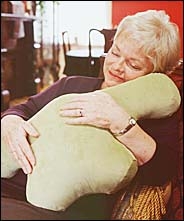
|
|
Reach Out and Hug Someone... Virtually
Based on a posting by Roba on the website "And Far Away"
Edited (with Introduction) by Dr. Don Rose, Writer, Life Alert
--
Here is an invention designed to provide "the Hug" you cannot give because you are too far away – or, perhaps, you’re too busy to go visit in person. This “interactive pillow” that mimics a hug could mark the start of a wave of devices designed to enhance the concept of a phone call, making it more emotive, enjoyable and meaningful. --Don Rose
--

Robotics researchers at Carnegie Mellon University (CMU) have designed a soft, huggable pillow that uses sensing and wireless phone technology to provide a nice added touch to your phone call – a physical touch, that is. This may result in better social and emotional support for family members (or, in theory, any two people desiring intimate contact across a distance). The device is about the size of a throw pillow but as firm as a seat cushion, and shaped like a person who is about to give a hug, with two arms reaching up and out from a small torso. The outside is covered in velour, "making it soft and plush and something you would want to hold up against your body."
Ideally, the Hug would be used by two people during a call – one Hug pillow on each end. The hug simulation probably feels more real to someone wanting to hug a child or grandchild, since the device is about the size of a small child. In addition, a “Hug call” would probably be more meaningful and anticipated by someone living alone, as many older folks do. Thus, if mass marketed, I imagine mature adults (especially those with grandchildren) would be the group most eager and likely to buy one and benefit from it.
This device is another example of technology attempting to bring us closer together. I was reminded of that famous “Reach out” phone commercial -- except now, you can "Reach out and hug someone" rather than just figuratively “touch” them. The Hug can also take “a message that includes voice and vibration patterns,” which apparently means that the device can store hugs for later delivery if the receiver is unavailable -- a kind of hug-voicemail system, if you will.
Certainly the Hug seems capable of enhancing the feeling of closeness between family members -- in particular, between seniors living alone and their children. For the kids, it's the next best thing to being there (with ma, pa, grandma or grandpa). I predict the Hug will prove to be only one initial example of many products designed to make older folks feel more companionship and love while living home alone. As an increasing number of seniors continue living in their own homes, rather than move to nursing homes or assisted living facilities, the field of intelligent home technology should boom, along with services that help make one’s domestic experience as safe and enjoyable as possible. The Hug helps enhance the “enjoyable” part, while a service like Life Alert, on the other hand, covers the goal of “safety” while living home alone; both are improvements to home living made possible via technology.
For more about the Hug, you can read the full original article here.For more information about Life Alert, visit http://www.lifealert.com.
The article above and the content it is based on are covered by a Creative Commons License. The information provided is, to the best of our knowledge, reliable and accurate. However, while Life Alert always strives to provide true, precise and consistent information, we cannot guarantee 100 percent accuracy. Readers are encouraged to gather more information before drawing conclusions and making decisions.
Dr. Don Rose writes books, papers and articles on many topics, including computers, the Internet, artificial intelligence, science and technology, and issues related to seniors.
More information about Life Alert, its emergency response services and other benefits for seniors nationwide is available at http://www.lifealert.com, http://www.seniorprotection.com and http://www.911seniors.com.
|

